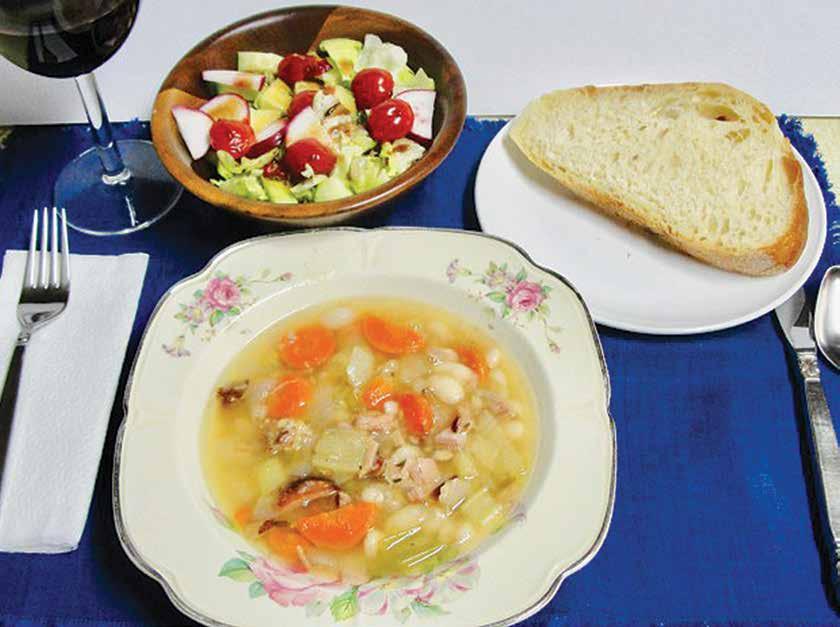
4 minute read
Ham and bean soup
are below average in wasting food. As a logical statement, this must be a selfevident falsehood.
Since I think my wife, Jerri, and I waste less food than most people, I offer a little quiz for the sake of comparison.
Question 1: Do you eat bananas after they have turned brown?
Question 2: Do you cut the “bad spot” off the apple you forgot about and eat it?
Question 3: Do you save three tablespoons of mashed potatoes for lunch?
Question 4: Do you save the tablespoon of leftover gravy to put on the potatoes?
Question 5: Do you boil the turkey carcass, pick off the meat and save the broth?
Question 6: Do you save ham bones to make soup?
If you can answer yes to all six, you are doing very well. But if you want to compete with Jerri, you have to answer yes to this question also.
Question 7: Do you clean out the shortening can with a spatula to save the last bit of grease to season the cast iron frying pans?
If your answer is a resounding YES! you are a leading warrior in the battle against food waste.
And if you’ve saved a ham bone, you have a good start on a great soup.
Ham and Great Northern Bean Soup
1 lb. great northern beans
Water
1 ham bone
Ham skin (if available)
1-2 cups chopped ham
1 or 2 chicken bouillon cubes
1½ cups chopped carrots
1½ cups chopped celery
1 cup chopped onion
2 cloves garlic
1 bay leaf
1 tsp. dried thyme
⅛ tsp. ground cloves
½ tsp. white pepper
Salt and black pepper if necessary
PROCEDURE:
Rinse the beans the night before, discarding any debris. When I was a kid, it was not uncommon to find a tiny stone or two in the dry beans. I haven’t found one in the last three or four years, but I always look. Put the beans into a large bowl and cover them with cold water.
Next morning, put the beans into a five-quart saucepan or Dutch oven and cover them with water. Bring the pan to a boil, reduce the heat and simmer the beans for about 45 minutes, until they begin to get tender. Drain the beans and set them aside. Reserve the bean water.
Put the ham bone into the Dutch oven or a soup pot. Cover the ham bone with cold water and bring the pot to a boil. Reduce the heat and simmer the bone for at least an hour to make the broth.
While the ham bone is simmering, clean and chop the vegetables. I like to chop the carrots into quarter-inch rounds, the celery into half-inch pieces and the onion into a quarter-inch dice. Mince the garlic and chop the ham. The amount of ham you need depends on how much meat was on the ham bone. I chop it into a half to threequarter-inch dice. Set the meat and vegetables aside in a bowl.
After simmering for an hour or so, the meat should be falling off the bone and most of the flavor from the bone and skin (if used) will be in the broth. Remove the ham bone and skin from the broth and set them aside to cool.
Add the chopped ham, chicken bouillon cube, vegetables, bay leaf, thyme, cloves and white pepper to the pot. If necessary, add enough of the bean water to cover the vegetables by a half inch or so. Bring the pot to a boil and reduce the heat to a simmer.
Remove the meat from the ham bone and add it to the soup. Mash a half-cup of beans and stir them into the soup, then add the rest of the beans plus a little more bean water and continue simmering the soup until the beans are tender.
Taste and adjust the seasoning with salt and freshly ground black pepper if necessary.
Serve with a salad and good bread.
NOTES: If the ham bone and meat are from a very salty ham, you might want to use only one bouillon cube. Add a teaspoonful of instant bouillon if the soup needs more salt when you first taste it. Stir and simmer the soup for a minute and taste it again before making the final adjustment. • • •
Many people are becoming more interested in reducing food waste. The USDA has a good page about the Food Waste Challenge that sponsors programs to help businesses and organizations achieve a goal of cutting food waste in half by 2030, usda.gov/ oce/foodwaste. The U.S. Environmental Protection Agency has an excellent site on the sustainable management of food, epa.gov/sustainable-management-food.
One good example of a program designed to reduce food waste was started several years ago at Pine City, Minn. Named after a western Wisconsin lady known for her Christian generosity, Ruby’s Pantry now serves dozens of communities in Minnesota and Wisconsin from distribution warehouses in southeastern Minnesota and central Wisconsin. Visit rubyspantry.org/fooddistributions/find-a-distribution-nearyou to find a location.
Trucks deliver food and other items to communities where volunteers work at a “Pop Up Pantry” once a month. Everyone is invited to attend. Ruby’s Pantry is devoted to sharing food and other necessities to anyone who can use them. People of all income levels and diet preferences are welcome. The only request is that you not waste the items you receive. If there is something that you cannot use, give it to a neighbor or a local food shelf.
That’s what Jerri and I do, and we think that it is a wonderful program.
Chuck Rang grew up on the South Shore and now lives in New Richmond, Wis., with his wife, Jerri. His blog, Courage in the Kitchen: Recipes and Reminiscences, appears on Area Voices, a product of Forum Communications Company. D









